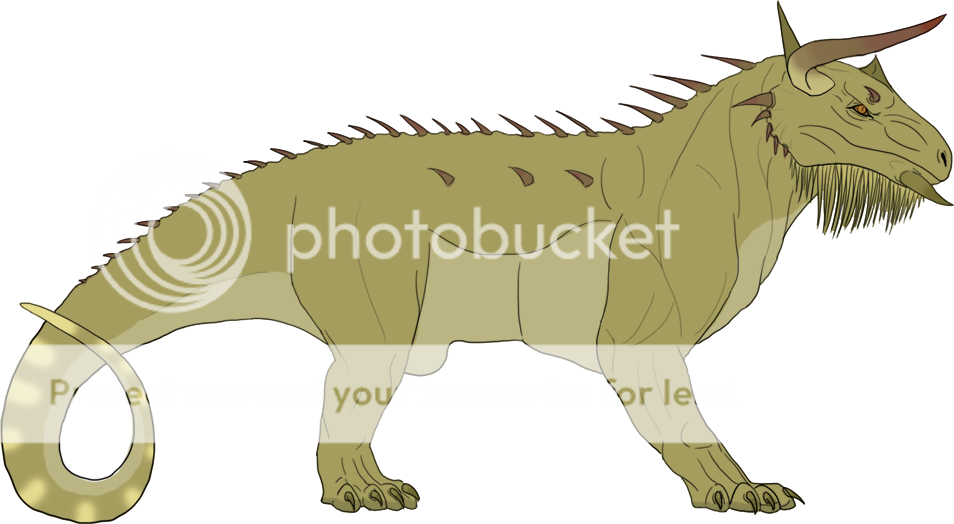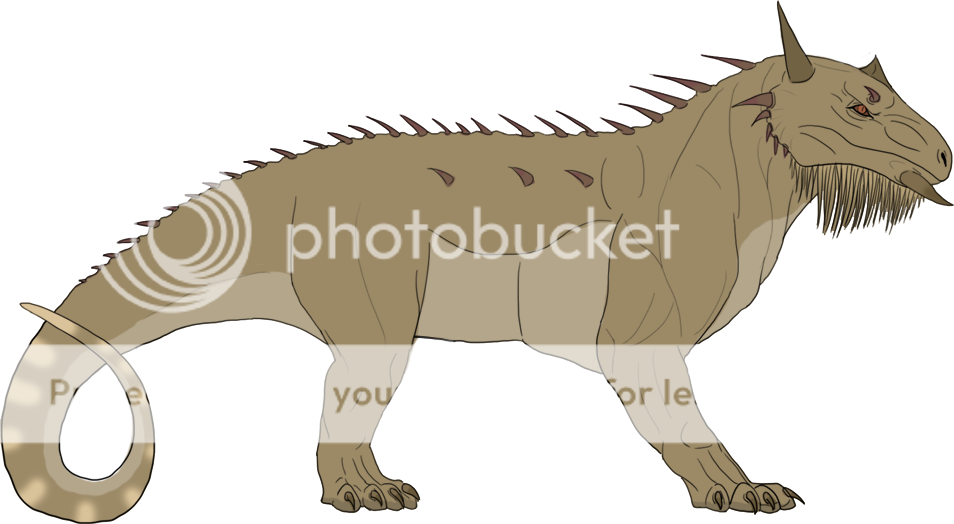[sub]*Credit for Creature goes to Siofra*[/sub]
Kahaya
[sub]"Bull Snake"[/sub]
[sup]Ka (Kah) which means "Bull" in Ancient Egyptian and Haya (hay-ya) which means “Snake” in Arabic.[/sup]
• Other names for it:
Sand Serpent, desert dragon, desert cow, bearded dragon, or the kúsi (means “Person who inspires fear or dread” in Old Norse).
Kahaya
[sub]"Bull Snake"[/sub]
[sup]Ka (Kah) which means "Bull" in Ancient Egyptian and Haya (hay-ya) which means “Snake” in Arabic.[/sup]
• Other names for it:
Sand Serpent, desert dragon, desert cow, bearded dragon, or the kúsi (means “Person who inspires fear or dread” in Old Norse).

[sub]Male[/sub]
Lives In:
[blockquote]• The rocky mountains of Simul towards the western end of the territory.[/blockquote]
They are the Size of a Rhinoceros:
[blockquote]*Male kahayas grow to range in height from five to seven feet. (1.52 to 2.13 meters)
*Females are shorter than the males and range from four to five feet high. (1.22 to 1.52 meters) [/blockquote]

Weight:
Males weight between 7,900 to 15,000 pounds. (3,583 to 6,804 kilograms)
Females weight between 6,000 to 8,800 pounds. (2,722 to 3 992 kilograms)
Pelt:
[blockquote]Its skin is similar to that of a horned lizard with sharper, shorter spikes and tiny, but thick, prickly scales. Occasionally males grow small spikes going up the center of their snout.
Males range in color from a light sandy color to a dark "wet sand" gray.

Females range in color from a slightly pink sand color to a dark, pinkish orange sand color.

They are Predators!
Diet:
[blockquote]
Large and small mammals
Reptiles and other lizards
Eggs and Offspring of other predators
Smaller kahaya offspring
Cactus juice (in dire droughts)
Physical Description:
[blockquote]• Along its upper sides are hooked talons that face towards the back end of the animal. This works in helping to protect its spine from being bitten from the larger jaws of other animals. A column of spikes starts from the back of the skull and ends about a fifth of the way down the tail. The tail acts like a whip against anything behind it.
• The beast’s frontal half is very muscular and tough. The feet face slightly outward and its strides are heavy and lugged. When the kahaya hunts, it lifts its toes slightly to prevent its long claws from scraping against the rocks.

• The eyes of the kahaya are located on the sides of its head, allowing it to see things in front and slightly behind it like most herbivores. This is caused by a rough evolution of being the prey animal before eventually becoming the hunter. The eyes of the kahaya are slits in daylight hours and become rounder at night to adjust to the darkness. Since the creatures are out in the desert, their eyes have developed an array of oranges like that of the African Elephant’s. It can see about 260 degrees around itself, with some restrictions from seeing directly behind itself and also because of some bulky muscle getting in the way of itself. This range of eyesight decreases 20% in the blinding desert sun.

• Because of having a large chest and body, the creature breathes heavily and is sometimes heard. When it is hunting it seems to breathe shallowly, but its mouth hangs slightly open in order to breathe more quietly. Inside the mouth are shorter, needle-like teeth with larger fangs in the canine area that be be about four inches long.
• The kahaya males are more heavily built than the females. Both male and female have large, broad and slanted shoulders with a collarbone to allow it to reach out to its sides and climb up walls better. Their upper halves, especially the necks, are thick in muscle and round (a little more oval for females) so that smaller animals biting down on them have trouble holding on, especially if the creature starts swinging about and their scales are starting to dig into their gums. Their back legs are a little slimmer than the front since it was built as more of a charger and fighter than a runner. [/blockquote]
Behavior:
[blockquote]For an overall behavior, a kahaya is a very territorial creature and will chase out anything they consider a threat to the very outskirts of their territory. It prefers to hunt by surprising its prey by either jumping from the rocks or cornering it. When it goes for the pounce from the rocks, it prefers to leap at the prey from a short distance and use its body weight to crush the animal. When it fights, it prefers to face its prey head on, like most animals, but it will lower its head and charge forward with wild, thrashing movements. When they bare their teeth in intimidation, their gums pull at least two inches up above the normal gum line to show more of its pearly teeth. Because of elusive involvement for many years, the kahaya’s are super aggressive towards them, the males becoming the most ballistic if they are caught before they have a chance to sneak up on the intruder from the rocks. The creatures, with a mild amount of intelligence, have been able to pick up on the scent of an elusive compared to that of whatever animal they are trying to look at. Although, the creatures don’t usually make this discovery unless an elusive has been standing in a spot for so long or have left a strong scent marking behind.[/blockquote]
[blockquote]
- The Male Kahaya (shown above):
- When a male kahaya charges forward, it angles its head so that its horns face towards the opposing creature, much like a bull. The males prefer to stand with their head held up as high as they can with its enormous jaws open wide intimidate the other. Males, when fighting for territory or mating rights, are seen with their mouths open at one another at very close distances for one to make the first move or to scare the other away.
The Female Kahaya (shown below):
- Females usually travel in small pods. The oldest female in a group of pods is the mother, while the others are its offspring. Females dig a slanted hole in the ground that eventually moves up as a small steppe where the female digs out a bowl shaped indent to lay her eggs in. When cornered the females will slowly sway their heads and tails back and forth in slow movements like a serpent if they believe that they cannot win a fight to try and scare the other away. They will also make chilling hissing noises to go along with it to greater its chance of chasing something away. The females, if protecting their nests and younglings (for up to three years), will be even more aggressive than the males, and usually the males will stay clear of them.
Intelligence:
[blockquote]The males are smarter than the females. Females can usually be more easily lead into a trap or charged into something or over a cliff than the males, who are tricky to fool. If a female's eyes are covered they will go into a mad frenzy by sprinting forward and bucking, and this method could be used to run them into things. If a male is blindfolded they will kick and whirl about on the spot and will usually rely on their sense of smell to figure out where they are.[/blockquote]
How they Hunt:
[blockquote]The kahaya eats anything it can gets its teeth on, but it mostly enjoys to hunt after larger desert animals that travel in herds. Since they blend in so well with the sand, if a herd gets too close to a rocky outcrop the kahayas will crawl around so that the herd is between them and the rocks. They then charge and, if successful, will corner at least one animal to which they will instantly kill. Only in dire situations will they ever be seen tearing at a cactus plant to drink the juices inside of it if the river running through the desert is completely dry.
The kahaya prefers the element of surprise when hunting above all else. It's bulky upper body allows it to absorb a large amount of shock when diving down from the rocks on top of its prey. When jumping down from the rocks, the kahaya puts its forelegs close together to ensure most of its weight hits its target. If they miss they quickly relax their muscles and spread their legs out so they don't break a bone (adolescent kahayas are more susceptible of fracturing their bones because of inexperience). Although it isn't a rare sight to see a kahaya walking around in the daylight hours, they are a lot more active at night and occasionally, during mating season, their loud roars can be heard as males challenge one another for a small family pod of females. [/blockquote]
Strengths:
[blockquote]Incredible strength and biting power. Their bites can easily crush bone and their sharp, razor teeth make it easier to rip things apart. Males sharpen their horns on rocks while both male and female sharpen their tusks, which will make each gender even more lethal when attacking. Their aggressive nature makes them dangerous to be around, especially during their mating season.
- Their eyesight at night makes hiding from them literally impossible unless they are very well camouflaged.
Their sense of smell is decent, but in daylight hours they don’t normally go sniffing about.
Weaknesses:
[blockquote]During the daylight hours the kahaya’s eyesight is mediocre and can’t see very long distances. They are practically unseen during the hottest hours of the day as they lay basking in the shade. Where the bottom jaw connects with the neck is a much thinner area of scale-less skin to make it more comfortable to open and close their terrible mouths. Around the armpits, lower belly, and groin area are also soft spots. If someone possessed sharp tools they can more easily pierce the hide of the beast, but the force of the blows must be strong.
For males, if a hunter encountered a male that is gaping its mouth open towards them in a threatening display, they could take the opportunity to try and shoot a weapon down its throat and wound it internally. Although, if they attack and the creature is smart enough to close its mouth or not open it at all, the sudden assault will cause the creature to charge.
Kahayas are nearly deaf and rely more on loud, vibrational communication. Their ear canals are very small and are more slanted towards the back, so it can hear things coming from behind a bit better than in the front. It is not deaf enough to speak loudly around at a close distance, but enough to be a little less stealthy when walking by.
Abilities:
[blockquote]
The kahayas are fairly good climbers since they mainly live in the rockier outcrops of the desert regions. Their strength is incredible with an average speed of about 30-40 mph, but they are somewhat slow to accelerate and don't take corners very well. They can run long distances because of their build. Their eyesight, although mediocre in the daylight, are exceptional during the nightly hours. The tusks on the front of their jaws act like diggers against the hard, dry earth so that it may keep its claws nice and sharp for hunting and defense. Females usually use this tool to dig out the side of a soft mound of dirt or even a huge, underground burrow during mating season that goes down in a steep arch many feet down before sharply turning upward and over a large step to where she’ll lay her eggs for protection against predators and the heavy rain showers that visit rarely every year.[/blockquote]

Lifespan
[blockquote]
Males: About 40-55 years
Females: About 50-65 years (Females are fertile from age three until about fifty-five years.)
Other
[blockquote]
- Elusives can safely eat the meat of a kahaya. The meat is really tough and iron-tasting because of the kahaya's huge muscles that need a lot of oxygen. The best way to eat the meat is to slow cook it over a fire so that it becomes tender, or they can boil it in water for a few hours to make the meat somewhat sweet tasting.
The kahaya live in the rockier areas of the desert and mostly in the tall rock structures that litter it. Females dig burrows before and during mating season if it is their first time, and males usually go around marking their territory or scraping their tusks and horns against the stones: slashes for the outskirts of their territory to straight up and down lines to warn others that they are getting too far into their land, and the second set of marks usually appear at least thirty feet inward or wherever the next large boulder is located beyond that.
This beast is found mostly in the desert regions and territories. During very dry seasons they are mostly found near areas of water. They are not as violent since they are more occupied in drinking than charging. However, if something gets close enough they will charge.
Kahaya females travel in what are known as pods. The maximum amount of kahaya in a pod is around four, give or take. The oldest in the pod is the mother of the others and seems to act as their leader and shepherd. When a kahaya first mates they break away from the pod and start their own. Adolescent males travel in twos, much like lions, and each takes a turn of luring the mother away from the pod before going after the younger ones. The mother of the pod can mate once it notices that its pod had mated and dispersed.
As stated before, kahayas use deep, vibrational communication. Their roars are much louder because of their large chests, and males have a tendency to make a type of croaking noise, but is very deep and rather painful to the sensitive ear. Much like the Siberian tiger, kahayas, when opening their jaws widely against the other and hissing, create a sudden cough of sound that can hurt the ears of the other and scare it away. Strangely they only do it during mating season against other male kahayas. Females do something similar, although it isn't as deep and not very painful.

[sub]Female[/sub]

